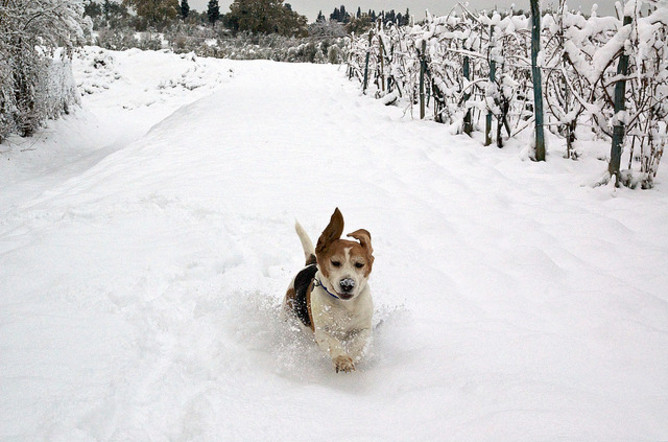
What Beagles Reveal about Alzheimer's in Humans

This article was originally published on The Conversation. The publication contributed this article to Live Science's Expert Voices: Op-Ed & Insights.
Every 67 seconds someone in the United States is diagnosed with Alzheimer’s disease and new estimates suggest that it may be the third leading cause of death of older people.
Alzheimer’s disease is associated with losses in memory in older people that become severe enough over time to interfere with normal daily functions. Other signs of Alzheimer’s include changes in the ability to communicate, losses in language, decreased ability to focus and to pay attention, impairments in judgment and other behavioral changes.
People with Alzheimer’s disease experience changes in their brains (which we can see in autopsies). Over the course of the disease, clumps of protein (called senile plaques) and tangles in neurons (called neurofibrillary tangles) accumulate. These plaques and tangles interfere with how the brain works and disrupt connections that are important for intact learning and memory ability.
The majority of studies to develop treatments for Alzheimer’s disease use mice that are genetically modified to produce human proteins with mutations. But these mutations are usually present in less than 5% of people with Alzheimer’s disease. This limitation can make it difficult to translate benefits of a treatment tested in mouse studies to people. However, there are several animals that naturally develop human-like brain changes that look much like Alzheimer’s disease, including dogs.
Old dogs, new research tricks
Old dogs may teach us a great deal about aging. As dogs get older, some develop learning and memory problems, much like we do. And like people, not all old dogs become impaired. Indeed, some old dogs remain bright and able to learn just as well as younger dogs, although they may be a little slower in reaching high levels of performance.

When an older dog has cognitive problems, we may see them as changes in behavior that can be disruptive to the relationship between owners and pets. For example, an old dog with cognitive problems may forget to signal to go outside, may be up at night and sleep all day, or have trouble recognizing people or other pets in the family. This is similar to a person with Alzheimer’s disease who may have difficulty communicating, disrupted sleep/wake cycles and trouble remembering family and friends.
Sign up for the Live Science daily newsletter now
Get the world’s most fascinating discoveries delivered straight to your inbox.
When aged dogs show cognitive changes not caused by other systemic illnesses, they are related to brain changes that are strikingly similar to people. For example, old dogs develop senile plaques in their brains that are made of a protein that is identical to one that humans produce. This protein, called beta-amyloid, is toxic to cells in the brain.
Unlike mice and rats, old dogs naturally develop significant brain pathology like we see in people. In this way, aging dogs may resemble aging humans in a more natural or realistic way than mice with genetic mutations.
There are many other changes in the brains of people with Alzheimer’s disease that are similar in aging dogs. These include changes in the blood vessels of the brain, the accumulation of damaged proteins and losses in cells, and chemicals that support cells in the brain. These changes may be modified by lifestyle factors.
Healthy living, healthy aging
There are many reports of how our lifestyle can be good or bad for aging. The food we eat can be a potent contributor to how our brains age. For example, several studies in people show that antioxidant-enriched diets (including lots of fruits and vegetables) and the Mediterranean diet are associated with healthier brain aging.
Physical exercise and good cardiovascular health also appear to be associated with a lower risk of developing Alzheimer’s disease and cerebrovascular disease, which is a cause of dementia. Keeping your brain active and challenged with puzzles, brain games and an engaging social life, are all linked to better memory and less risk of disease and studies are ongoing in people to measure the effects systematically.

Beagles and the brain
Dogs may be very well suited to help us understand how these lifestyle factors help our brains as we get older. Our lab initially began studying beagles in the early 1990s as there was interest in developing a drug to treat “dog dementia” based on pet owners observations of changes in behavior in their older dogs. At that time, little was known about learning and memory changes in aging dogs (beagles over eight years of age) and our earliest research was designed to find ways to systematically measure these changes.
The first step in doing this was to teach dogs to look at different objects (for example a Lego block or a toy truck) and learn that one of the two always hid a food reward. When we switched the food reward to the object that was previously not rewarded, older dogs kept choosing the wrong object. Young dogs very quickly switched over to the new object.
When we counted the number of errors dogs make to learn the problem, old dogs made many more errors overall. Interestingly, not all old dogs were impaired. Another subset of old dogs showed significant losses in their ability to remember information and some showed changes in their ability to be “flexible” in changing behaviors.
This is very similar to people. Not everyone ages in the same way – some people remain sharp as tacks well into their older years. After measuring learning and memory changes in dogs, we next studied the brain changes that were most strongly linked to these cognitive losses. We found that senile plaques in the brains of old dogs were more frequent in the animals that had learning and memory problems. In our more recent studies, we have been seeking ways to improve brain health in old dogs with the hope that these approaches can translate to healthy aging in people.

For instance, in several studies of aging in beagles, we have found that a diet rich in antioxidants that includes vitamins E and C, and importantly, fruits and vegetables, can lead to wonderful benefits in learning and memory ability that can be maintained for years.
For example, dogs that had trouble remembering where they had seen a food reward (this is an example of spatial memory) showed significant improvements in their memory over time. Also, old dogs showed rapid improvements in their ability to modify their behaviors when the rules had changed in the task they were learning (an example of enhanced executive function).
In addition, providing dogs with physical exercise, social enrichment and “brain games” (like the food reward game) can also significantly improve cognition as they get older.
If we take these factors into account, we may be able to engage in strategies and lifestyle changes that will be good for both species. Exercise, social interaction, learning new tricks – participating in the same activities with our aged companion animals, the benefits will be twofold: for them and for us.
This article was originally published on The Conversation. Read the original article. Follow all of the Expert Voices issues and debates — and become part of the discussion — on Facebook, Twitter and Google +. The views expressed are those of the author and do not necessarily reflect the views of the publisher. This version of the article was originally published on Live Science.









